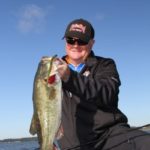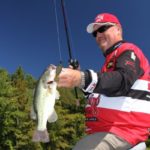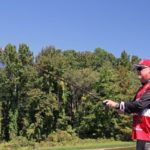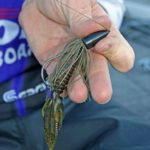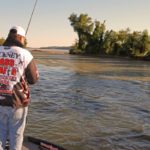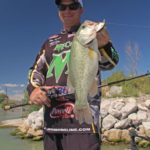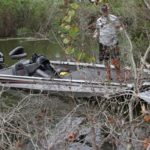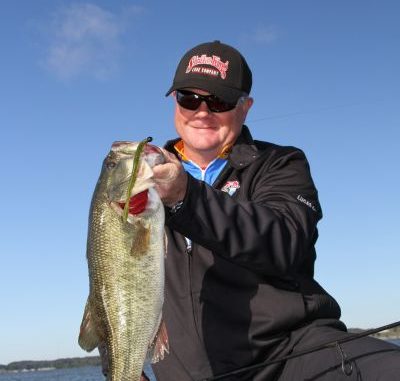
Cold fronts usually shut a hot bite down, but that doesn’t mean bass don’t still need to feed. Here are some tips on how to put bass in the boat, even on those dreaded bluebird days.
As the year draws to a close, you can count on weather fluctuations, compliments of cold air masses descending from the north.
These periods of barometric and meteorological changes bear significant impact on your string-stretching pursuits, so let’s be up front about what happens after a front: It’s tough, at least for a full day.
Catching bass is not exactly impossible, but a cake walk it’s not.
The process starts with an approaching front dropping the barometric pressure and stimulating a flurry of feeding. Cloudy skies and sometimes rain lead the frontal boundary, so bending a rod during a front’s passage is a pretty good bet.
However, once the front clears, high pressure and dreaded bluebird skies arrive on the backside.
West Monroe’s FLW Tour pro Jim Dillard said that’s when skill is really tested.
“Usually when a front comes through, the first day is ok, but that second day is when the fish get really tight to cover and they don’t want to feed,” Dillard explained. “You just have to slow down and get tight to cover with them.”
Now, even though bass might not feel like feeding, they know they have to eat to live. That means that if you want them to bite your bait, you have to make it easy and convenient.
Consider first the challenges of post-frontal conditions. Some impact anglers, while others directly affect the fish.
“The first thing that’s tough is that most of the time you have a north wind that blows all the water out,” Bassmaster Elite Series pro and Pierre Part native Cliff Crochet said. “You were fishing 3 to 4 feet of water and then, sometimes, it’s down to nothing.
“Second thing is the high pressure. It makes them tough to catch.”
Now, that’s a point with more assumption than scientific foundation. Anglers often contend that the spiking barometer irritates a fish’s inner ear, but that’s largely speculative.
Nevertheless, a query to Wes Porak, Florida Bass Conservation Center fisheries biologist, said it’s hard to nail down.
“Changing pressure likely affects a lot of physiological processes that I do not fully understand,” Porak said. “Effects of changes in atmospheric pressure on the pressure in the otic capsule, which encapsulates the inner ear makes sense, and it might have some influence on the fish’s balance.
“However, pressure changes and temperature changes will also influence the exchange of gasses and possibly the exchange of ions occurring across the membranes of the gills — altering the uptake of oxygen and release of carbon monoxide. These rates of exchange may also be impacted at the cellular level.”
In other words, respiratory challenges can cause fish to become profoundly sluggish in high-pressure conditions.
One thing that’s inescapable is the giant flood light in the sky: Bass mught be able to tolerate a little temperature swing, if the front’s not a killer chiller, but unyielding sunshine will send the fish running every time.
“Fish don’t have eyelids like you and me, so when it’s bright and sunny they have to get under something to shield their eyes,” FLW Series pro Dennis Berhorst said.
So, conditions are tough, but you still have to find some way to salvage the day. Whether you’re fishing competitively or just for fun, that’s a tough bill to fill.
Suffice it to say that success under bluebird skies requires adjustments — both in tactics and perspective.
Elite pro Jason Christie said a change in perspective is required.
“The thing you have to remember is that you’re not fishing for a lot of bites,” Christie explained. “You’re just fishing for a few key bites, so you want to make each one of them count.”
To Christie’s point, consider that the fish will be far less inclined to chase baits. In stable conditions, fish roam during cloudy or overcast weather — but sunshine pulls them tight to cover.
That’s bass fishing 101, but understand that a cold front amplifies this principle to dramatic levels. So, if a partly sunny day during stable conditions is a mallet, the dreaded bluebird sky is a sledge hammer.
One thing Crochet adamantly stressed is that acceptance and adjustment are a much better strategy than avoidance.
“You can’t necessarily run from the wind because that can make you run away from the fish,” he said. “But with the high pressure and all that sunshine, you have to slow down and not rush your way through.”
To optimize his chances, Crochet looks for two key elements on a bluebird day.
Firstly, he searches for off-color water. It doesn’t have to be dirty — just enough color to moderate the jitters fish get in periods of ultra-high visibility.
The next key is cover. Docks, wood, vegetation — anything to block that sunlight.
Dillard pointed to hydrilla, lily pads, hyacinth, etc., as a natural sun shields for bass. This is definitely a more-is-better deal, so get in the thickest stuff you can find, he said.
Also, he views cypress trees as a common solace for post-frontal bass.
“A cypress tree forms a canopy as it comes out at the base,” Dillard said. “It has the snarled roots, and then it will break under and make a canopy under the tree. The fish will tuck under that canopy.
“That’s why it’s important to hit the tree with your bait and make it fall down by the roots. Don’t just swim a bait by a tree — make it bump up in there and then follow the contour down to where the fish are.”
FLW pro Mark Rose noted the wisdom of playing off the baits that were producing prior to a cold front and trying to recapture that interest in scaled-back presentations.
“If I’ve been covering the flats and the fish are eating a Strike King Redeye Shad ahead of the front, if I still feel like they’ll do that in the post-front, I might go to a non-rattling version of that bait,” said Rose. “Or if I’m catching them on a 1.5 squarebill, I might go to a silent one; if I’m throwing a ½-ounce buzzbait before the front, I might go to a ¼-ounce.”
Likewise, Toledo Bend guide Stephen Johnston’s a big fan of bladed vibrating jigs, but sometimes those bluebird days find the fish just lazily nipping at his V&M Lightning Blade.
Johnston overcomes this by fishing the bait sans trailer. Casting distance shortens with the lighter bait, but the more-compact profile tends to nab more of those short-strikers.
In closing, Crochet offered some advice on post-front positioning. While fish will typically be tight to cover, that cover doesn’t have to be tight to the shoreline.
“I’m looking for cover somewhat out from the bank,” he said. “Instead of passing my boat right by a laydown and fishing back to the trunk, I’ll stay 10 feet off of it and fish the outer branches.”
